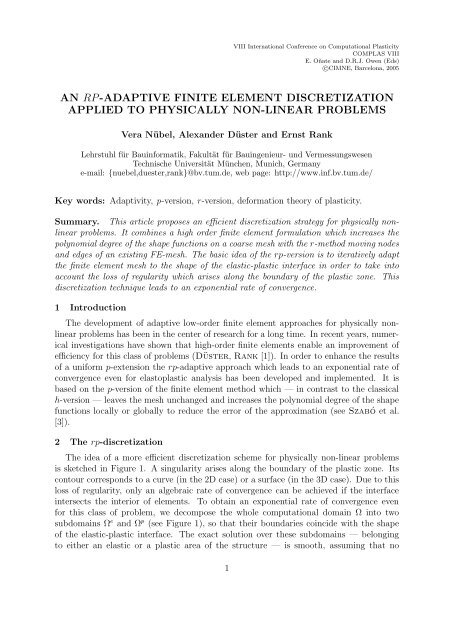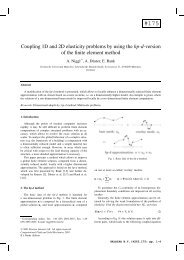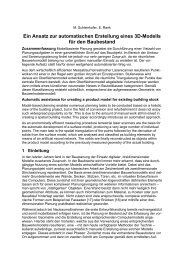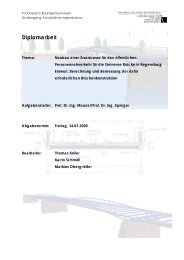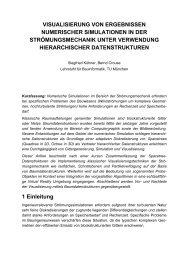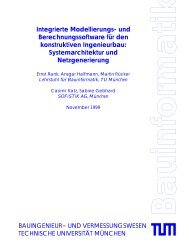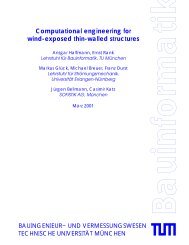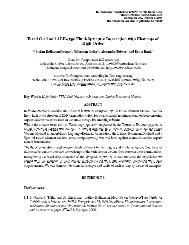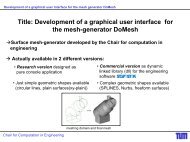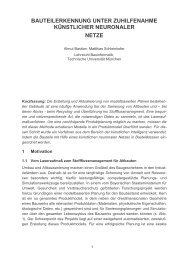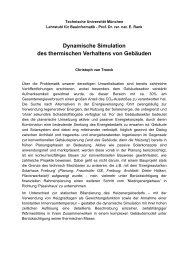an rp-adaptive finite element discretization applied to physically non ...
an rp-adaptive finite element discretization applied to physically non ...
an rp-adaptive finite element discretization applied to physically non ...
Create successful ePaper yourself
Turn your PDF publications into a flip-book with our unique Google optimized e-Paper software.
VIII International Conference on Computational PlasticityCOMPLAS VIIIE. Oñate <strong>an</strong>d D.R.J. Owen (Eds)c○CIMNE, Barcelona, 2005AN RP -ADAPTIVE FINITE ELEMENT DISCRETIZATIONAPPLIED TO PHYSICALLY NON-LINEAR PROBLEMSVera Nübel, Alex<strong>an</strong>der Düster <strong>an</strong>d Ernst R<strong>an</strong>kLehrstuhl für Bauinformatik, Fakultät für Bauingenieur- und VermessungswesenTechnische Universität München, Munich, Germ<strong>an</strong>ye-mail: {nuebel,duester,r<strong>an</strong>k}@bv.tum.de, web page: http://www.inf.bv.tum.de/Key words: Adaptivity, p-version, r-version, deformation theory of plasticity.Summary. This article proposes <strong>an</strong> efficient <strong>discretization</strong> strategy for <strong>physically</strong> <strong>non</strong>linea<strong>rp</strong>roblems. It combines a high order <strong>finite</strong> <strong>element</strong> formulation which increases thepolynomial degree of the shape functions on a coarse mesh with the r-method moving nodes<strong>an</strong>d edges of <strong>an</strong> existing FE-mesh. The basic idea of the <strong>rp</strong>-version is <strong>to</strong> iteratively adaptthe <strong>finite</strong> <strong>element</strong> mesh <strong>to</strong> the shape of the elastic-plastic interface in order <strong>to</strong> take in<strong>to</strong>account the loss of regularity which arises along the boundary of the plastic zone. This<strong>discretization</strong> technique leads <strong>to</strong> <strong>an</strong> exponential rate of convergence.1 IntroductionThe development of <strong>adaptive</strong> low-order <strong>finite</strong> <strong>element</strong> approaches for <strong>physically</strong> <strong>non</strong>linea<strong>rp</strong>roblems has been in the center of research for a long time. In recent years, numericalinvestigations have shown that high-order <strong>finite</strong> <strong>element</strong>s enable <strong>an</strong> improvement ofefficiency for this class of problems (Düster, R<strong>an</strong>k [1]). In order <strong>to</strong> enh<strong>an</strong>ce the resultsof a uniform p-extension the <strong>rp</strong>-<strong>adaptive</strong> approach which leads <strong>to</strong> <strong>an</strong> exponential rate ofconvergence even for elas<strong>to</strong>plastic <strong>an</strong>alysis has been developed <strong>an</strong>d implemented. It isbased on the p-version of the <strong>finite</strong> <strong>element</strong> method which — in contrast <strong>to</strong> the classicalh-version — leaves the mesh unch<strong>an</strong>ged <strong>an</strong>d increases the polynomial degree of the shapefunctions locally or globally <strong>to</strong> reduce the error of the approximation (see Szabó et al.[3]).2 The <strong>rp</strong>-<strong>discretization</strong>The idea of a more efficient <strong>discretization</strong> scheme for <strong>physically</strong> <strong>non</strong>-linear problemsis sketched in Figure 1. A singularity arises along the boundary of the plastic zone. Itscon<strong>to</strong>ur corresponds <strong>to</strong> a curve (in the 2D case) or a surface (in the 3D case). Due <strong>to</strong> thisloss of regularity, only <strong>an</strong> algebraic rate of convergence c<strong>an</strong> be achieved if the interfaceintersects the interior of <strong>element</strong>s. To obtain <strong>an</strong> exponential rate of convergence evenfor this class of problem, we decompose the whole computational domain Ω in<strong>to</strong> twosubdomains Ω e <strong>an</strong>d Ω p (see Figure 1), so that their boundaries coincide with the shapeof the elastic-plastic interface. The exact solution over these subdomains — belonging<strong>to</strong> either <strong>an</strong> elastic or a plastic area of the structure — is smooth, assuming that no1
Vera Nübel, Alex<strong>an</strong>der Düster <strong>an</strong>d Ernst R<strong>an</strong>kadditional singularities occur, such as those due <strong>to</strong> reentr<strong>an</strong>t corners. Each subdomain isthen discretized by the p-version <strong>applied</strong> on a coarse mesh, where no refinement <strong>to</strong>wardsthe elastic-plastic interface is necessary. The computational domain with a <strong>non</strong>-smoothsolution is split in<strong>to</strong> areas for which regular solutions do exist. As the boundary ofthe elastic-plastic interface describes <strong>an</strong> arbitrarily curved con<strong>to</strong>ur, <strong>element</strong> edges areaccordingly shaped. To describe such arbitrarily bounded <strong>element</strong>s we use the blendingfunction method first proposed by Gordon <strong>an</strong>d Hall (see [3]). It is <strong>an</strong> import<strong>an</strong>t featureof the p-version that enables a large varity of <strong>element</strong> shapes.PSfrag replacementsΓ NtΩΩ eΩ puΓ DFigure 1: Domain Ω, decomposed in<strong>to</strong> <strong>an</strong> elastic region Ω e <strong>an</strong>d a plastic region Ω pAs position <strong>an</strong>d shape of the elastic-plastic interface are not known a priori, <strong>an</strong> <strong>rp</strong><strong>adaptive</strong>algorithm iteratively detects the boundary of the plastic zone. Within this<strong>adaptive</strong> cycle <strong>element</strong>s may be arbitrarily curved <strong>an</strong>d strongly dis<strong>to</strong>rted. As the p-version is very robust with respect <strong>to</strong> dis<strong>to</strong>rtion (see Szabó et al. [3]), these effects c<strong>an</strong> becompensated with <strong>an</strong> increase of the polynomial degree of the <strong>finite</strong> <strong>element</strong> computation.3 Numerical examplesNumerical studies on the <strong>rp</strong>-<strong>adaptive</strong> approach for two-dimensional problems haveshown that the proposed <strong>discretization</strong> strategy enables <strong>an</strong> improvement of efficiency<strong>an</strong>d provides accurate results [4]. Furthermore it turned out <strong>to</strong> be superior <strong>to</strong> <strong>adaptive</strong>h-version approaches when investigating the example of a rect<strong>an</strong>gular domain with acentral hole which has been defined by Stein et al. [2] as a benchmark problem forthe joint Germ<strong>an</strong> research project ’Adaptive Finite-Element-Methods in ComputationalMech<strong>an</strong>ics’. This c<strong>an</strong> be seen from Figure 2 which shows the relative error in u y in [%]at point 4, located at the upper right corner. Three of the corresponding <strong>finite</strong>-<strong>element</strong>meshes,arising during the <strong>rp</strong>-<strong>adaptive</strong> cycle, are presented in Figure 3.A similar behaviour of the <strong>rp</strong>-method c<strong>an</strong> be observed in 3D, when investigating the threedimensionalproblem of a thick-walled hollow sphere under internal pressure. Figure 4shows the results for a uniform h-version, a p-version with a priori adjusted interface atthe plastic front <strong>an</strong>d <strong>an</strong> <strong>adaptive</strong> <strong>rp</strong>-version.2
tnb hr1 234567PSfrag replacementsVera Nübel, Alex<strong>an</strong>der Düster <strong>an</strong>d Ernst R<strong>an</strong>krelative error of uy,FE, at point 4 [%]1001010.10.010.0010.00011e-05<strong>adaptive</strong> <strong>rp</strong>-version64,256,1024,4096 graded Q1-P0 <strong>element</strong>s875 adapted Q1-P0 <strong>element</strong>suniform h-version, p=2PSfrag replacementsrelative error of u y,FE , at point 4 [%]degrees of freedom N<strong>adaptive</strong> <strong>rp</strong>-version64,256,1024,4096 graded Q1-P0 <strong>element</strong>s875 adapted Q1-P0 <strong>element</strong>suniform h-version, p=21e-0610 100 1000 10000 100000 1e+06degrees of freedom Nyht n5761 2bx43rFigure 2: Relative error |u y,ref −u y,F E|u y,ref100 [%] at point 4Figure 3: Finite <strong>element</strong> meshes during the <strong>rp</strong>-<strong>adaptive</strong> algorithm (iteration steps 3,4,5)A detailed discussion on the efficiency of the <strong>rp</strong>-method for the deformation theory ofplasticity is given in [4].4 ConclusionsThe proposed <strong>rp</strong>-<strong>adaptive</strong> algorithm for <strong>physically</strong> <strong>non</strong>-linear problems iteratively detectsthe boundary of the elastic-plastic interface <strong>to</strong> subdivide the whole computationaldomain with a <strong>non</strong>-regular solution in<strong>to</strong> areas where smooth solutions exist. If the shapeof the plastic zone is represented accurately, <strong>an</strong> exponential rate of convergence c<strong>an</strong> beobtained even for this class of problems.3
1e+02PSfrag replacementsxyzVera Nübel, Alex<strong>an</strong>der Düster <strong>an</strong>d Ernst R<strong>an</strong>krira1e+021e+011e+00PSfrag replacementsrelative error η [%]1e+011e+001e-011e-021e-031e-04interface mesh, 6 <strong>element</strong>suniform h-version, p=2<strong>adaptive</strong> <strong>rp</strong>-version1e+021e+011e+001e-011e-021e-031e-041e-051e+001e+011e+021e+031e+041e+051e+06relative error η [%]degrees of freedom Ninterface mesh, 6 <strong>element</strong>suniform h-version, p=2<strong>adaptive</strong> <strong>rp</strong>-versionyzr ir ax1e-051e+01 1e+02 1e+03 1e+04 1e+05 1e+06degrees of freedom N√|Uref −UFigure 4: Relative error η =F E|∫U ref100 [%] with U = 1 2 Ω εT σ dΩ for 3D-problemAcknowledgementThis study has been sponsored with the help of a gr<strong>an</strong>t from the Deutsche Forschungsgemeinschaft(DFG, RA 624/6-3, RA 624/6-4). This support is gratefully acknowledged.REFERENCES[1] A. Düster <strong>an</strong>d E. R<strong>an</strong>k. The p-version of the <strong>finite</strong> <strong>element</strong> method compared <strong>to</strong><strong>an</strong> <strong>adaptive</strong> h-version for the deformation theory of plasticity, Computer Methods inApplied Mech<strong>an</strong>ics <strong>an</strong>d Engineering, 190, 1925-1935, 2001.[2] E. Stein. Error-Controlled Adaptive Finite Elements in Solid Mech<strong>an</strong>ics, John Wiley& Sons, 2002.[3] B. Szabó, A. Düster <strong>an</strong>d E. R<strong>an</strong>k. The p-version of the <strong>finite</strong> <strong>element</strong> method, In:Encyclopedia of Computational Mech<strong>an</strong>ics, E. Stein, R. de Borst <strong>an</strong>d T. Hughes,edi<strong>to</strong>rs, John Wiley & Sons, 2004.[4] V. Nübel, A. Düster <strong>an</strong>d E. R<strong>an</strong>k. An <strong>rp</strong>-<strong>adaptive</strong> <strong>finite</strong> <strong>element</strong> method for thedeformation theory of plasticity, submitted <strong>to</strong>: Computational Mech<strong>an</strong>ics, 2004.4


